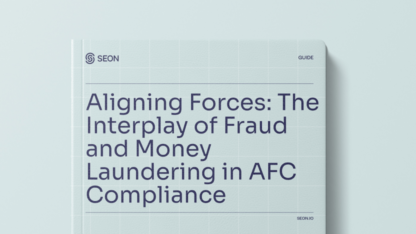The Financial Crimes Enforcement Network (FinCEN) received 3.8 million Suspicious Activity Reports (SARs) in 2024 — averaging more than 10,400 reports per day. This highlights the growing need for effective Anti-Money Laundering (AML) checks to spot and flag potential financial crimes.
In line with these efforts, the European Union’s 6th Anti-Money Laundering Directive (6AMLD), recently finalized in 2024, expands the scope of predicate offenses to include cybercrime and tax crimes, further strengthening global AML regulations. To comply with these evolving standards and mitigate risks, financial institutions and businesses are increasingly adopting advanced technological solutions, such as AI-driven AML verification processes and real-time transaction monitoring.
As we navigate this complex regulatory environment, understanding the intricacies of AML verification processes is crucial for ensuring effective compliance and safeguarding against financial crimes.
What Is AML Verification?
AML verification, or an AML check, is a data collection and analysis protocol that financial institutions must follow to conduct transactions. In practice, it is a background vetting process conducted during customer onboarding and throughout the customer journey to meet existing expectations for SAR reporting.
The process ensures compliance with anti-terrorist legislation, like the Banking Secrecy Act in the US, the European 6AMLD regulation and other mandates that help safeguard the global economy.AML checks often overlap with the data gathered from the KYC verification process, though AML verification typically considers additional information. While KYC checks are required for financial and other entities, AML verification incorporates broader data-based strategies to specifically address money laundering risks.
How Does AML Verification Work?
To comply with international mandates, financial institutions must validate the name, date of birth and address of the account holder. According to legislation, these data points are sufficient to establish confidence in a customer’s profile regarding potential liability. The institution assesses this personal information and ensures the individual or entity is not listed on sanctions, blacklists or PEP lists.
However, determining the beneficiary of a commercial entity can be more complex. Money laundering operations often hide the true ownership of commercial accounts to use them as bank drops.
Plausible deniability is another tactic used to conceal transactions. In some cases, bad actors within a company may knowingly permit criminal activities for financial gain. When accountability is required, these companies often leverage the confusion caused by shifting the blame to evade liability.
To address this, Article 7 of 6AMLD assigns explicit criminal responsibility to situations where a “lack of supervision or control” enables a criminal act. Previously, vague liability definitions made legal action difficult, but the law now requires a responsible professional, if not the beneficial owner, to be held accountable.
Why Are AML Verification Important?
AML verification is essential because it helps prevent money laundering, financing of terrorism, and other financial crimes by identifying and stopping suspicious activities early. It plays a critical role in protecting the integrity of the global financial system and ensuring businesses remain compliant with regulations like the 6th Anti-Money Laundering Directive (6AMLD). By verifying customer identities and monitoring transactions, companies can avoid facilitating illicit activity—intentionally or not—and reduce the risk of severe legal and financial penalties.
For companies subject to 6AMLD, the consequences of non-compliance are substantial. While there is no minimum fine specified for companies under 6AMLD, the maximum penalties can be severe, including fines of up to €5 million or 10% of annual turnover, whichever is greater. Additionally, non-compliant entities may face:
- Denial of governmental benefits, such as grants and public funding.
- Temporary or permanent cessation of business activities.
- Judicial surveillance.
- Court-ordered closures of physical premises.
These stringent measures underscore the necessity for businesses to implement effective AML verification processes to ensure compliance and mitigate the risk of such penalties.
SEON’s AML rules engine detects suspicious activities efficiently, combining rules-based monitoring with machine learning to keep your business ahead of risks.
Learn more
What Documentation Is Required for an AML Verification?
To perform valid AML verification, financial institutions typically require documentation that aligns with KYC compliance. This includes:
- Government-issued ID (e.g., passport, driver’s license) confirming name and nationality
- Proof of address (e.g., utility bill, government correspondence)
- Beneficial ownership details, confirmed through direct contact
- Source of funds backed by financial records
- Ongoing updates, as required by local regulations
These documents are verified using identity verification software (IDV). Photocopies may be accepted if paired with a risk assessment. Institutions also screen individuals against sanctions lists, PEP lists, and other blacklists to ensure full AML compliance. This process follows global standards, including those set by the Financial Action Task Force (FATF).
Who Needs to Comply with AML Regulations?
AML regulations aim to protect the global economy from terrorism, corruption, cross-border crime, and other illicit activities. Any organization that could directly or indirectly facilitate such activities is required to adhere to these mandates. While AML compliance is a given in banking, its reach extends to industries like iGaming, fintech, and high-value trading, depending on the country.
Key Sectors Subject to AML Verification
GGlobally, AML regulations apply to various sectors beyond financial institutions, particularly where hidden funds are common. This includes luxury real estate transactions, often involving shell companies, as well as businesses trading in high-value items like art and antiques. Additionally, both online and offline gambling and iGaming enterprises are subject to these regulations.
Industries typically required to comply with AML regulations include property and business brokers, high-value item dealers, financial managers, banking services and trust and fund management companies. These sectors must adhere to strict AML standards to prevent money laundering and maintain financial integrity, ensuring they stay on the right side of AML laws and protect themselves from legal and reputational risks.
How Can SEON Help?
SEON’s AML software facilitates risk assessment by checking against PEPs, RCAs, watchlists and sanctions lists. Our real-time data and machine learning algorithms help identify potential threats, escalate suspicious activities and approve legitimate customers with minimal friction.
With SEON, teams can:
- Spot synthetic identities and AML liabilities
- Flag PEPs and monitor them closely
- Detect suspicious connections and patterns
- Conduct real-time transaction monitoring
- Verify identities without intrusive methods
- Assess location data validity
- Source data for SARs and reference AML datasets
SEON simplifies compliance and reporting, saving time and operational costs while enhancing fraud prevention. By streamlining AML processes, SEON helps create a safer business environment, free from money laundering and supports ongoing compliance throughout the customer journey.
Compare top AML tools to protect your business, reduce fraud, and streamline compliance with real-time screening and AI-powered monitoring.
Read reviews here
Frequently Asked Questions
Typically, financial institutions, fintech companies, and regulated businesses are responsible. Designated compliance officers or teams use AML software and ID verification tools to meet regulatory requirements and ensure ongoing due diligence.
AML verification helps detect and prevent financial crimes like money laundering and terrorism financing by verifying customer identities and monitoring transactions. It ensures businesses remain compliant with local and international regulations.
A beneficial owner is defined as a single entity that owns or controls an interest in a legal or commercial entity, such as a company, property, or security. Most commonly, though, knowing the beneficial owner answers the question “Whose money is this, really?” This designation of ownership is in place for the sake of legal responsibility when it comes to that entity’s conduct in the larger economy.
When transaction monitoring software flags suspicious data, the information is compiled in a report called a SAR – or Suspicious Activity Report. It is formatted in a specific way so that financial analysts and regulators may review it.
The easiest way to submit a SAR is via a free online system – via the BSA E-Filing System in the US or the NCA website in the UK, for example. Some transaction monitoring software will also include a feature to automatically file them for you.
In the screenshot above, SEON is used to pause the journey of customers from high-risk countries to be reviewed manually.
Sources
- GOV.UK: Who needs to register for money laundering supervision
- Willkie Compliance: Who is Subject to US AML Laws?
- FinCEN: Frequently Asked Questions Regarding Customer Due Diligence Requirements for Financial Institutions









